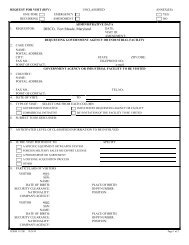DSS ACCESS, Volume 1, Issue 3 - Defense Security Service (DSS)
DSS ACCESS, Volume 1, Issue 3 - Defense Security Service (DSS)
DSS ACCESS, Volume 1, Issue 3 - Defense Security Service (DSS)
Create successful ePaper yourself
Turn your PDF publications into a flip-book with our unique Google optimized e-Paper software.
TIMELINE: Publications By the <strong>Defense</strong> Investigative <strong>Service</strong> in, from left, 1989, 1990, 1992, 1993.<br />
1,750 were military) were transferred<br />
from the military services to DIS for the<br />
establishment of the PSI mission. By the<br />
end of FY84, <strong>DSS</strong> was an entirely civilian<br />
organization.<br />
At the time of its standup, DIS was also assigned<br />
responsibility to maintain the <strong>Defense</strong> Central Index<br />
of Investigations (DCII) for the Department. At the<br />
time, DCII was maintained on an IBM 360/40 computer<br />
located at Fort Holabird, Md. The DCII Master Index<br />
was composed of approximately 15 million locator<br />
records for investigations conducted by or for DoD<br />
investigative agencies and retained by them.<br />
In 1977, DIS was assigned the mission of law<br />
enforcement in detecting fraud, waste and abuse in<br />
DoD. Unlike other new missions that remained with<br />
the agency, this mission was transferred to the DoD<br />
Inspector General in 1981 and the <strong>Defense</strong> Criminal<br />
Investigative <strong>Service</strong> (DCIS) was then formed. At the<br />
time, the criminal investigation mission under DIS<br />
focused primarily of the theft of government property<br />
at facilities of the <strong>Defense</strong> Logistics Agency (DLA).<br />
A major change in the agency’s mission set occurred<br />
in 1980 when the Industrial <strong>Security</strong> Program was<br />
transferred from DLA to DIS. The goal was to achieve<br />
industrial security coordination among the military<br />
services and the <strong>Defense</strong> Agencies. To implement<br />
the Industrial <strong>Security</strong> mission, DLA transferred 670<br />
personnel spaces while the military services added<br />
88 more. Shortly after the transfer, in September<br />
1980, there were approximately 10,733 facilities in the<br />
<strong>Defense</strong> Industrial <strong>Security</strong> Program.<br />
The National Industrial <strong>Security</strong> Program (NISP) was<br />
created by Executive Order 12829 in January 1993,<br />
and was intended to replace not only the DISP, but the<br />
industrial security programs of the Central Intelligence<br />
Agency, the Department of Energy, and the Nuclear<br />
Regulatory Commission. The National Industrial<br />
<strong>Security</strong> Program Operating Manual (NISPOM) became<br />
effective on April 1, 1995, formally implementing the<br />
National Industrial <strong>Security</strong> Program. It was considered<br />
the most significant change in the Industrial <strong>Security</strong><br />
Program in nearly 40 years.<br />
Today, the NISPOM (revised and re-issued on February<br />
28, 2006) serves as the basis for <strong>DSS</strong> oversight of the<br />
program. There are approximately 13,300 facilities<br />
cleared under the NISP and the industrial security<br />
program forms the foundation of the agency’s current<br />
mission set.<br />
During the same time, <strong>DSS</strong> was providing administrative<br />
support for the DoD <strong>Security</strong> Institute (DoDSI) located<br />
near Richmond, Va. DoDSI trained DIS personnel security<br />
investigators and industrial security representatives<br />
and also offered resident and extension courses for U.S.<br />
government employees and industry representatives.<br />
In 1983, the Institute trained approximately 3,800<br />
students. In 1997, <strong>Defense</strong> Reform Initiative #2 directed<br />
http://www.dss.mil —— 9




